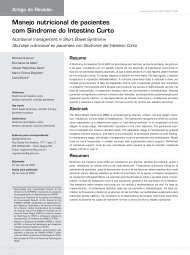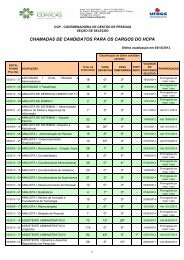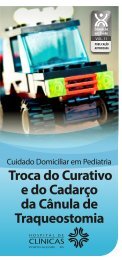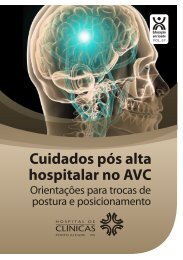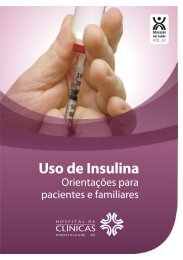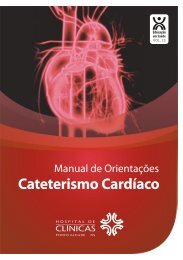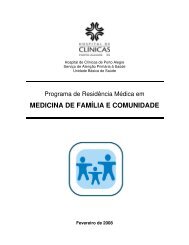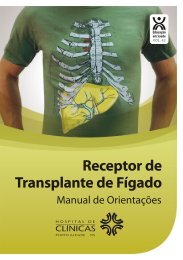Anais da 27º Semana CientÃfica - Hospital de ClÃnicas de Porto Alegre
Anais da 27º Semana CientÃfica - Hospital de ClÃnicas de Porto Alegre
Anais da 27º Semana CientÃfica - Hospital de ClÃnicas de Porto Alegre
You also want an ePaper? Increase the reach of your titles
YUMPU automatically turns print PDFs into web optimized ePapers that Google loves.
189<br />
Revista HCPA 2007; 27 (Supl.1)<br />
criticamente enfermos, necessitando na sua maioria <strong>de</strong> outros suportes vitais, como o uso <strong>de</strong> vasopressor e <strong>de</strong> VM. Busca na<br />
literatura será realiza<strong>da</strong> com o objetivo <strong>de</strong> comparar a nossa população com a <strong>de</strong> outros CsTI.<br />
AVALIAÇÃO DA PERCEPÇÃO DA QUALIDADE DE VIDA E DEPRESSÃO ENTRE PACIENTES COM INSUFICIÊNCIA<br />
RENAL CRÔNICA (IRC) EM PROGRAMA DE HEMODIÁLISE<br />
ANA CLÁUDIA MACEDO DA MATTA; MARI ANGELA VICTORIA LOURENCI; SIMONE CAZORLA BORBA; JOSÉ<br />
ALBERTO RODRIGUES PEDROSO<br />
Introdução: A Depressão é um dos diagnósticos psiquiátricos mais prevalentes em pacientes com IRC em hemodiálise. Pelas<br />
características inerentes à terapia dialítica, sua quali<strong>da</strong><strong>de</strong> <strong>de</strong> vi<strong>da</strong> po<strong>de</strong> estar prejudica<strong>da</strong>. Como parte <strong>da</strong> abor<strong>da</strong>gem<br />
multidisciplinar, torna-se importante a aplicação <strong>de</strong> questionários <strong>de</strong> avaliação, cuja vali<strong>da</strong><strong>de</strong> seja reconheci<strong>da</strong> e reprodutibili<strong>da</strong><strong>de</strong><br />
seja comparável. Objetivos: Avaliar a percepção <strong>da</strong> quali<strong>da</strong><strong>de</strong> <strong>de</strong> vi<strong>da</strong>, a prevalência e intensi<strong>da</strong><strong>de</strong> <strong>de</strong> <strong>de</strong>pressão em pacientes<br />
renais crônicos <strong>de</strong> uma Clínica <strong>de</strong> Hemodiálise em <strong>Porto</strong> <strong>Alegre</strong>. Material e Métodos: 36 Pacientes foram submetidos ao<br />
questionário SF-36 ® e ao Inventário <strong>de</strong> Beck para Depressão (BDI). O primeiro avalia a dimensão <strong>da</strong> saú<strong>de</strong> em escalas, <strong>de</strong> 0 a<br />
100, informando sobre o estado geral <strong>de</strong> saú<strong>de</strong>, aspecto físico, emocional, social, dor, vitali<strong>da</strong><strong>de</strong> e saú<strong>de</strong> mental. O BDI categoriza<br />
a <strong>de</strong>pressão em ausente, mínima, leve, mo<strong>de</strong>ra<strong>da</strong> ou grave. Resultados: A i<strong>da</strong><strong>de</strong> média era <strong>de</strong> 60 anos (41-85), com igual<br />
proporção <strong>de</strong> homens e mulheres (n=18). Consi<strong>de</strong>rando dois grupos distintos pela i<strong>da</strong><strong>de</strong> (menor ou ≥ a 60 anos), notou-se<br />
diferença entre os escores, segundo i<strong>da</strong><strong>de</strong>, para capaci<strong>da</strong><strong>de</strong> funcional, aspecto físico, vitali<strong>da</strong><strong>de</strong> e dor (pior em idosos). Depressão<br />
Mínima (50%, n=18) e Leve (30%; n=11) foram mais freqüentes. Seis apresentaram <strong>de</strong>pressão mo<strong>de</strong>ra<strong>da</strong> (16%), dos quais apenas<br />
1 abaixo <strong>de</strong> 60 anos. Nenhum apresentou <strong>de</strong>pressão grave pelo escore BDI. Conclusão: Os pacientes idosos apresentam percepção<br />
pior <strong>da</strong> sua quali<strong>da</strong><strong>de</strong> <strong>de</strong> vi<strong>da</strong> no que se refere à intensi<strong>da</strong><strong>de</strong> <strong>da</strong> condição física atual, maior inferência <strong>de</strong> dor nas suas ativi<strong>da</strong><strong>de</strong>s e<br />
também maiores sentimentos <strong>de</strong> <strong>de</strong>sanimo, nervosismo, cansaço e tristeza. O BDI mostrou um índice significativo <strong>de</strong> <strong>de</strong>pressão<br />
nos pacientes com Insuficiência Renal.<br />
QUILÚRIA NÃO PARASITÁRIA, EM ÁREA NÃO ENDÊMICA, APRESENTANDO-SE COMO PROTEINÚRIA DE NÍVEL<br />
NEFRÓTICA: TESTES SIMPLES NO DIAGNÓSTICO DIFERENCIAL<br />
NOEMIA PERLI GOLDRAICH; CARMEN PILLA<br />
Chyluria is the excretion of chyle from the urinary tract (UT) and indicates the presence of an abnormal communication between<br />
intestinal lymphatics and the UT. Southern Brazil is not an en<strong>de</strong>mic region for filariasis. AIM: report a case of a 14-yrs Caucasian<br />
girl referred to Pediatric Nephrology Out-Patients. History: she started to pass milky urine with white clots at the age of 12yrs. No<br />
e<strong>de</strong>ma. Investigation in another hospital inclu<strong>de</strong>d a renal biopsy that was normal. A diagnosis of nephrotic syndrome was ma<strong>de</strong>.<br />
She was treated initially with steroids and after changed to cyclosporin, lisinopril and simvastatin. Physical examination: 49kg,<br />
1.62m, BP: 90/60mmHg, no e<strong>de</strong>ma. Laboratory <strong>da</strong>ta: milky urine with white clots. Urinalysis: specific gravity 1024, 4+ proteins,<br />
pH 6.5, < 3 RBC, 4WBC. Urine tests: 24h-proteinuria: 9.07g, proteinogram: albumin: 51.2%, alfa1: 10.8%, alfa2: 11.5%, beta:<br />
4.8%, gamma: 11,7%, cholesterol: 14mg/dL, triglyceri<strong>de</strong>s: 603mg/dL. Blood tests: albumin: 2.92g/L, cholesterol: 166mg/dL,<br />
HDL: 53mg/dL, triglyceri<strong>de</strong>s: 105mg/dL; creatinine:0.7mg/dL. Imaging: normal kidneys on ultrasound. Filariasis, tuberculosis<br />
and neoplasms were exclu<strong>de</strong>d as etiology for chyluria. Congenital anomalies of the lymphatic system are un<strong>de</strong>r investigation.<br />
CONCLUSION: chyluria, although a rare condition especially in children and adolescent in non-en<strong>de</strong>mic areas, should be<br />
inclu<strong>de</strong>d in the differential diagnosis of nephrotic syndrome. Macroscopic examination of the urine, that is milky and cloudy, is<br />
simple and very helpful. Also, triglyceri<strong>de</strong>s are found only in the urine of patients with chyluria. These simple tests will avoid<br />
unnecessary treatment, which is not without si<strong>de</strong> effects.<br />
AVALIAÇÃO DA PRESENÇA DE ANTICORPOS ANTI-HLA NO PRIMEIRO ANO DO TRANSPLANTE RENAL<br />
REALDETE TORESAN; LUIZ FERNANDO JOB JOBIM; ROBERTO CERATTI MANFRO; MARIA CONCEIÇÃO DA<br />
COSTA PROENÇA; PATRÍCIA HARTSTEIN SALIM; FRANCISCO JOSÉ VERÍSSIMO VERONESE; DANIEL<br />
MELQUÍADES DA SILVA; ADRIANA REGINATO RIBEIRO; MARIA ISABEL ALBANO EDELWEISS; KARLA LAIS<br />
PEGAS<br />
Introdução: Pacientes que possuem anticorpos anti-HLA no pós-transplante apresentam maior incidência <strong>de</strong> rejeição agu<strong>da</strong> (RA) e<br />
<strong>de</strong> nefropatia crônica do enxerto (NCE). Objetivo: Avaliar a presença <strong>de</strong> anticorpos anti-HLA no primeiro ano do transplante<br />
renal e verificar sua associação com a ocorrência <strong>de</strong> RA e NCE.Materiais e Métodos: Este estudo incluiu 88 pacientes submetidos<br />
a transplante renal no período <strong>de</strong> outubro <strong>de</strong> 2002 a outubro <strong>de</strong> 2004. Amostras <strong>de</strong> sangue foram colhi<strong>da</strong>s no 1°, 3°, 6° e 12°<br />
meses pós-transplante, visando à pesquisa <strong>de</strong> anticorpos IgG anti-HLA (ELISA LAT-M e LAT1240, One Lamb<strong>da</strong>, USA). Nos<br />
pacientes que consentiram, biópsias renais <strong>de</strong> protocolo foram realiza<strong>da</strong>s entre o 2° e o 3° mês e no 12° mês pós-transplante. RA e<br />
NCE foram diagnostica<strong>da</strong>s por critérios clínicos, laboratoriais e histopatológicos. Resultados e Conclusões: Dos pacientes<br />
avaliados, 40 (45,5%) eram do sexo feminino e 72 (81,8%) <strong>de</strong> etnia caucasói<strong>de</strong>. Setenta e um (80,6%) receberam rins <strong>de</strong> doador<br />
falecido. Anticorpos anti-HLA foram encontrados em 20 pacientes (22,7%). No seguimento até um ano, 23 pacientes (26,1%)<br />
apresentaram RA e 43 (51,2%) <strong>de</strong>senvolveram NCE. Setenta por cento dos pacientes com RA <strong>de</strong>senvolveram NCE, contra 45,3%<br />
dos pacientes sem RA (P=0,054). Nove (45%) pacientes com anticorpos anti-HLA <strong>de</strong>senvolveram RA, contra 14 (20,6%) dos sem<br />
anticorpos (P=0,058) e 11 (64,7%) <strong>de</strong>senvolveram NCE contra 32 (47,8%) dos sem anticorpos (P=0,329). Na análise histológica,<br />
anticorpos anti-HLA foram associados à RA IIA (P=0,001) e à NCE II (P=0,012). A pesquisa <strong>de</strong>sses anticorpos no póstransplante<br />
se adota<strong>da</strong> como rotina, po<strong>de</strong>ria i<strong>de</strong>ntificar casos <strong>de</strong> mau prognóstico e guiar a escolha <strong>de</strong> tratamentos mais a<strong>de</strong>quados.<br />
Nossos resultados reforçam a necessi<strong>da</strong><strong>de</strong> <strong>de</strong> continui<strong>da</strong><strong>de</strong> <strong>de</strong>sses estudos.




